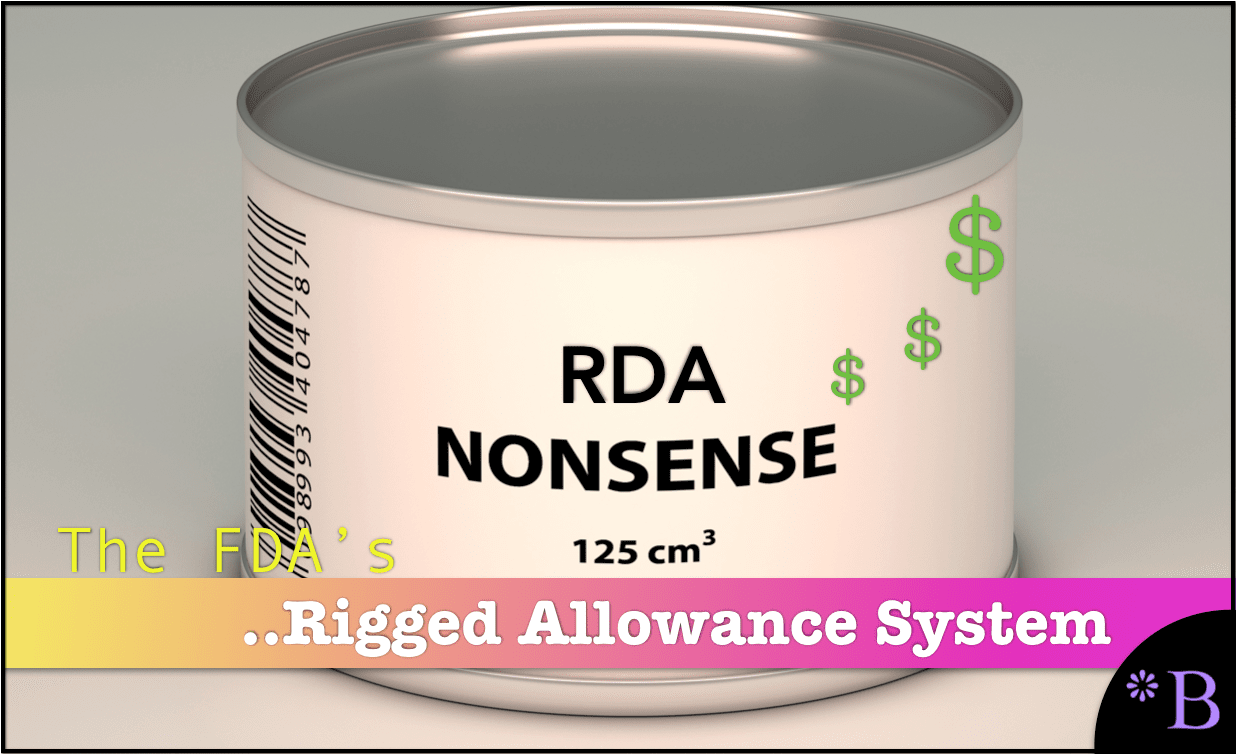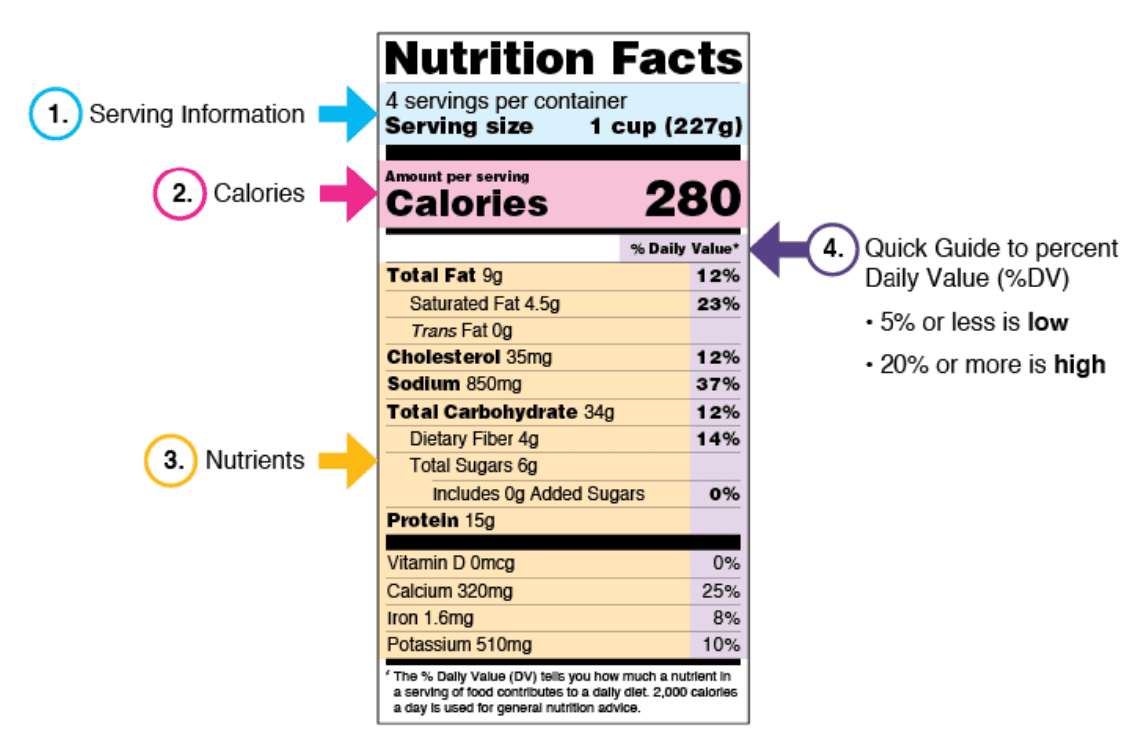How the Recommended Daily Allowances or RDAs Are Set Too Low by the FDA
Executive Summary
- The FDA keeps the RDAs so low that they are outdated with the research into vitamins and minerals.
- We cover why the FDA does this.

Introduction
The FDA keeps the RDAs artificially low. As the FDA knows better, there can only be a few reasons why it does this.
Our References for This Article
If you want to see our references for this article and related Brightwork articles, visit this link.
The FDA’s Ludicrous Vitamin D3 (Aka Vitamin D) RDA
Vitamin D is explained in this video. It also demonstrates that the medical and pharmaceutical companies promoted deficient levels of recommended Vitamin D is still being used. The evidence is that much higher levels of Vitamin D are necessary for the proper functioning of the immune system. Still, the FDA is not interested in updating their RDAs with this evidence. The study states that the medical establishment has ignored the studies on Vitamin D. The video states that health authorities have not updated the information on Vitamin D for 100 years.
- Dr. Campbell states that he does not know why the recommended levels have not been updated, and he calls the fact they don’t is a form of negligence.
- But I believe he does know. It is due to pharmaceutical interests infecting public health. Dr. Campbell may be afraid of being punished by YouTube for saying why the Vitamin D RDA has not been increased to match the findings in the literature.
The video is absolutely fascinating and contains a deceptively large amount of information presented very effectively. Yet, it only covers one aspect of Vitamin D deficiency. Vitamin D is related to reduced depression, reduced obesity, better cardiovascular health, improved bone density, and many other benefits. There should be a concerted effort to ensure that the population is educated on obtaining a sufficient about of Vitamin D. Even though roughly 90% of the population is deficient in Vitamin D, there has been no push to reduce this deficiency. However, enormous amounts of pharmaceutical research and revenues have come from conditions that are partly due to a deficiency of Vitamin D.
Even though this video shows how outdated the RDA is for Vitamin D (as just one example), observe this quote from Wikipedia on the RDAs.
The RDAs (and later the RDA values within the DRI) were regularly revised to reflect the latest scientific information, but although the nutrition labeling regulations were occasionally updated, the existing RDI values were not changed, so that until 2016, many of the DVs used on nutrition facts labels were still based on the outdated RDAs from 1968. – Wikipedia
Observe how the second part of the paragraph contradicts the first part of the paragraph and how it is contradicted by the video above. The RDA for Vitamin D is still set at 800 IUs and increased from 400 IUs, which was absurdly low. The Wikipedia entry does not discuss the FDA’s capture by pharmaceutical or processed food companies but presents the FDA as only concerned with public health. This is very standard coverage that is repeated elsewhere.
The FDA’s Lack of Interest in the RDAs
The RDAs are created by the FDA, which barely does any supplement research, and which are promoted by drug companies to minimize the RDAs. The NIH has a budget of between 30 to 40 billion dollars per year — but they have almost no money for natural supplement research, as virtually all of the funding is earmarked for pharmaceutical companies.
The NIH like the FDA views its role as to fund pharmaceutical companies product development. This is how NIH and FDA officials can make the most money for themselves, as they have financial conflicts with the pharmaceutical companies. This places the focus where pharmaceutical companies want it (on their products and on patent medicine in general), but I also create more customers for high-profit margin pharmaceuticals — as deficiencies eventually lead to disease. This is why during covid, there was virtually no emphasis on improving immune system function, as I cover in the article Why Are Some Natural Supplements Effective Treatments for Covid?
And this means denigrating all-natural substances or any evil “generics” that must be discredited to redirect people to take only drugs currently on the patent. Therefore, it is not only denigrating vitamins and minerals, but also pharmaceuticals that are generics and no longer on patents.
The RDAs Are Set to the Minimum to Prevent Deficiency
It is further not declared that the RDAs are not determined for health — they are determined to prevent deficiency, as per extremely dated studies.

Setting the RDAs low serves two constituents. First is pharmaceutical companies that want a de-nutrified public that drives them to pharmaceuticals. A second is processed food companies. If the RDAs are set low, it makes their de-nutrified and high-profit margin, food look better and more healthy than it really is.
A question that is never addressed in the common coverage of RDAs is how people of very different body weights and different lifestyles can be covered by one set of RDAs?
Some Vitamins become more necessary to receive supplementation based upon seasonality. One of these is Vitamin D, which is biosynthesized within the body in reaction to sunlight — which is naturally far more common in summer than winter. How can the Vitamin D RDA be the same throughout the year?
This is explained in the following quotation.
This might be an even more damning criticism. The numbers in the RDA report are designed to prevent obvious deficiency, not to achieve optimal health. So if you follow their recommendation for Vitamin D, you won’t get rickets; if you follow the recommendation for Vitamin B1, you won’t get beriberi. It’s definitely better not to have these diseases than to have them, but just the fact that you don’t have rickets or beriberi doesn’t make you healthy. – Paleo Leap
It is extremely rare for the RDAs to be questioned, and only a tiny fraction of the US population, or global population — has any idea how inaccurate and misleading the FDA RDAs are.
Talking About the FDA’s RDAs Without Actually Understanding Them
People writing on the topic of the RDAs will often quote the FDA RDAs without understanding the corrupt approach they are created and who created them.
- Groupthink on the RDAs: This is a constant problem with the FDA — they are not sufficiently questioned, and they produce a large amount of false information.
- The Universal Presentation on RDAs: Without reviewing the failings and biases of the FDA, it is straightforward to get lulled back into the thought process that the FDA is a legitimate organization looking out for public health. This is because so few sources question the FDA, and the FDA is ubiquitous in public life and is constantly referred to as a legitimate source.
The Many Areas of Problems With How The FDA Looks At Vitamins and Minerals
The following quotations are quite instructive.
On a side note, Nutrition Facts labels aren’t required to list any vitamins and minerals except vitamin A, vitamin C, calcium, iron, and sodium. Why not the others? Because the FDA did not consider them vital for Americans. There are many arguments on how that is not in agreement with current scientific evidence. – Linus Pauling Institute
And this…
1 The FDA (and Department of Agriculture) do not believe that whole natural organic foods contain any nutrients not found in other foods and that depleted soils do not affect food quality.
2 They do not believe that whole natural complexes contain substances essential to robust life.
3 They define Vitamins as only one of the components of the entire complex. For example, tocopherol is defined as Vitamin E, even though it is only one of at least six different groups of molecules in the natural Vitamin E complex.
4 They believe that a synthetic single molecule does the same function as the whole natural complex.
Point four has been known for decades, so it is bizarre that the FDA is still a hold-out on this topic. This brings up the question of how many people at the FDA even know much about vitamins and minerals.
The quote continues…
5 They barely accept the proposition that nutrition deficiencies are related to disease!
This is also difficult to believe. However, it is reinforced by the fact that the FDA does not focus on vitamin and mineral deficiency.
The quote continues…
6 The RDA definition states that the RDA is the amount of a nutrient that a healthy person needs to remain healthy. The great nutritional biochemist Roger Williams proved that even genetically identical individuals (mice in this case) might have as much as a 20 fold difference in need for a specific nutrient. That means that the definition only applies to those lucky few who have a lower nutrient need than most. Do, say, ½% of the population really determine what the other 99½ % need? If mice can have a twenty-fold difference how much difference in need do humans have?
9 Nutritional needs are also proportional to the stress experienced by the individual. The higher the stress the more the body and mind have to work, so the greater the nutritional needs. This is exactly like your automobile requiring more gas to drive faster! These days there is generally greater psychological stress, but perhaps more importantly for this purpose, there is more water, air, and food pollution (not to mention electromagnetic–which can interfere with normal metabolism). Toxins from these food sources as well as drugs, vaccines, antibiotics, and other substances have increased total toxin intake by, my guess, 10,000 times what it was a century ago. No wonder that so many people are obese, sick, suffer from cancer, infections, low energy, and so on. – Natural Bioenergetics
Who would want such an entity to determine the RDAs?
The FDA very clearly has little interest in regulating food, and they also have a conflict of interest as they represent not public health, but pharmaceutical interests. It would make more sense to divide the FDA into two, a Food Administration and a Drug Administration. This would allow the new divided Food Administration to actually care about and focus on food regulation.
Understanding the USDA’s Corrupt “MyPlate”
The USDA is primarily a free lobbyist group for the food industry and is actively involved in undermining public health through providing inaccurate information on food and nutrition.
The MyPlate campaign to confuse the public is a good example of this.